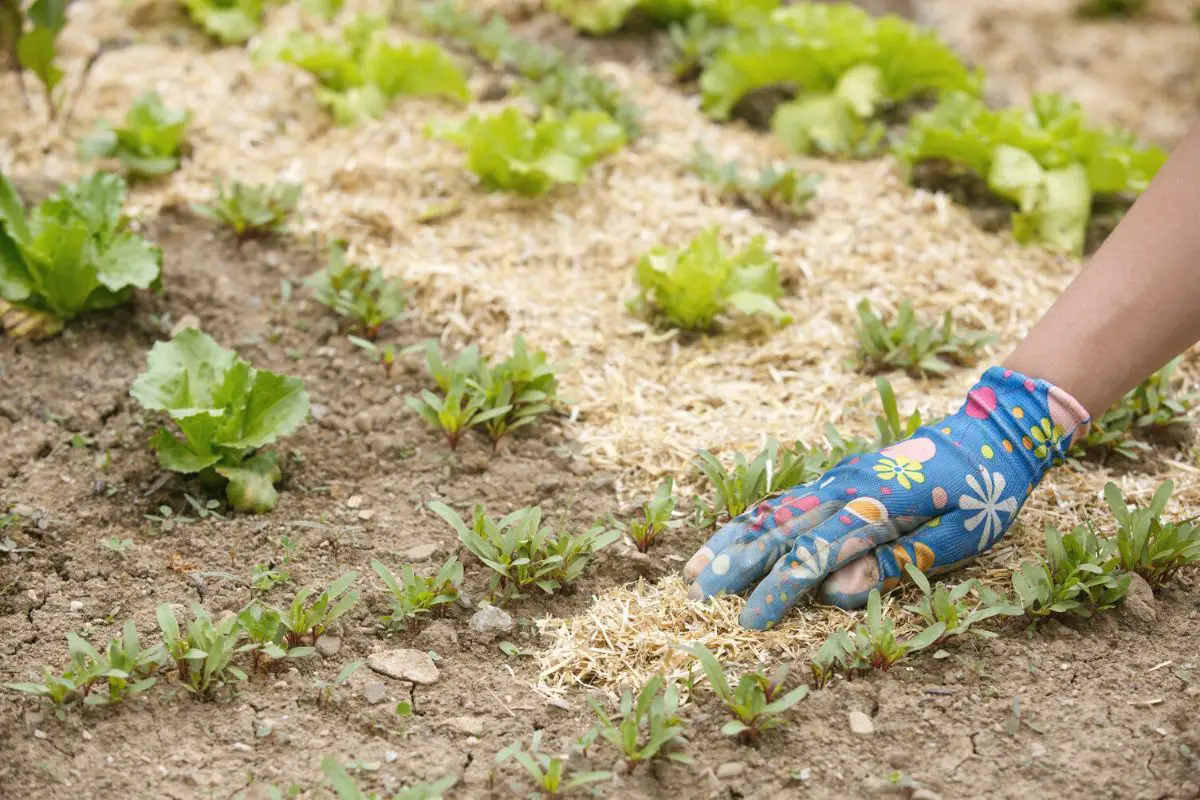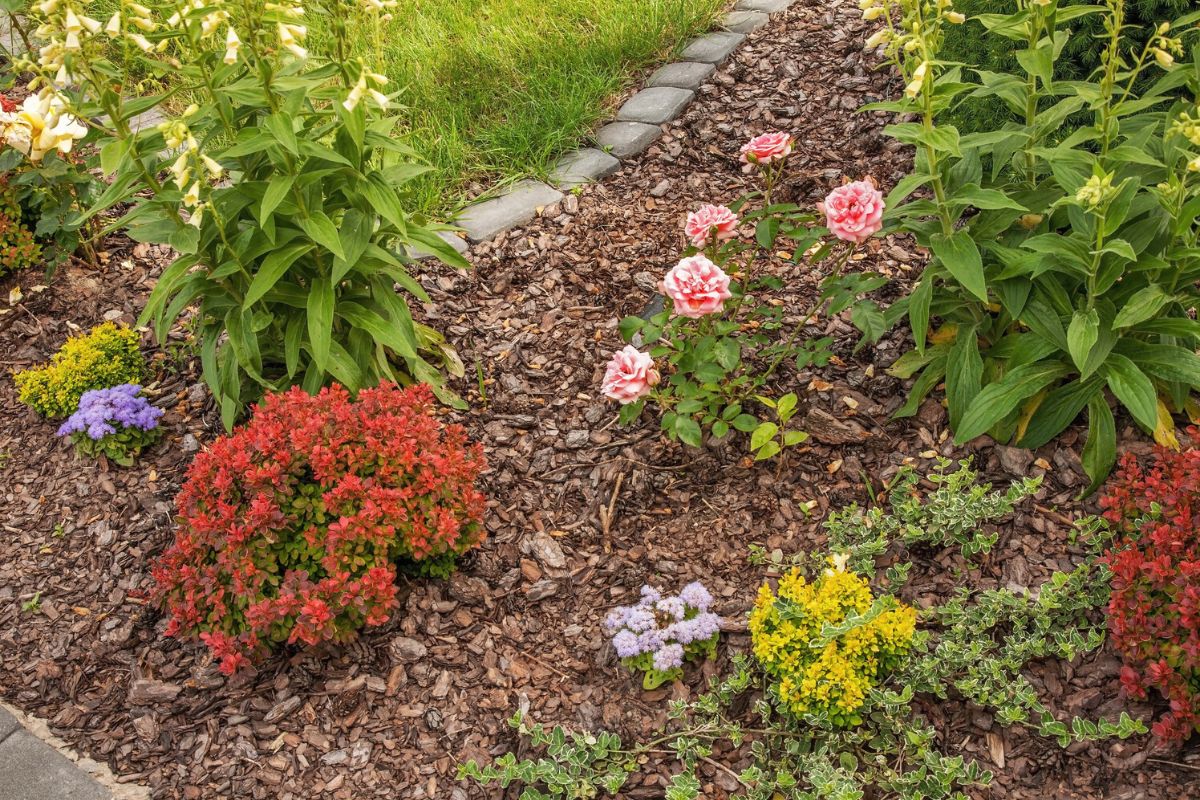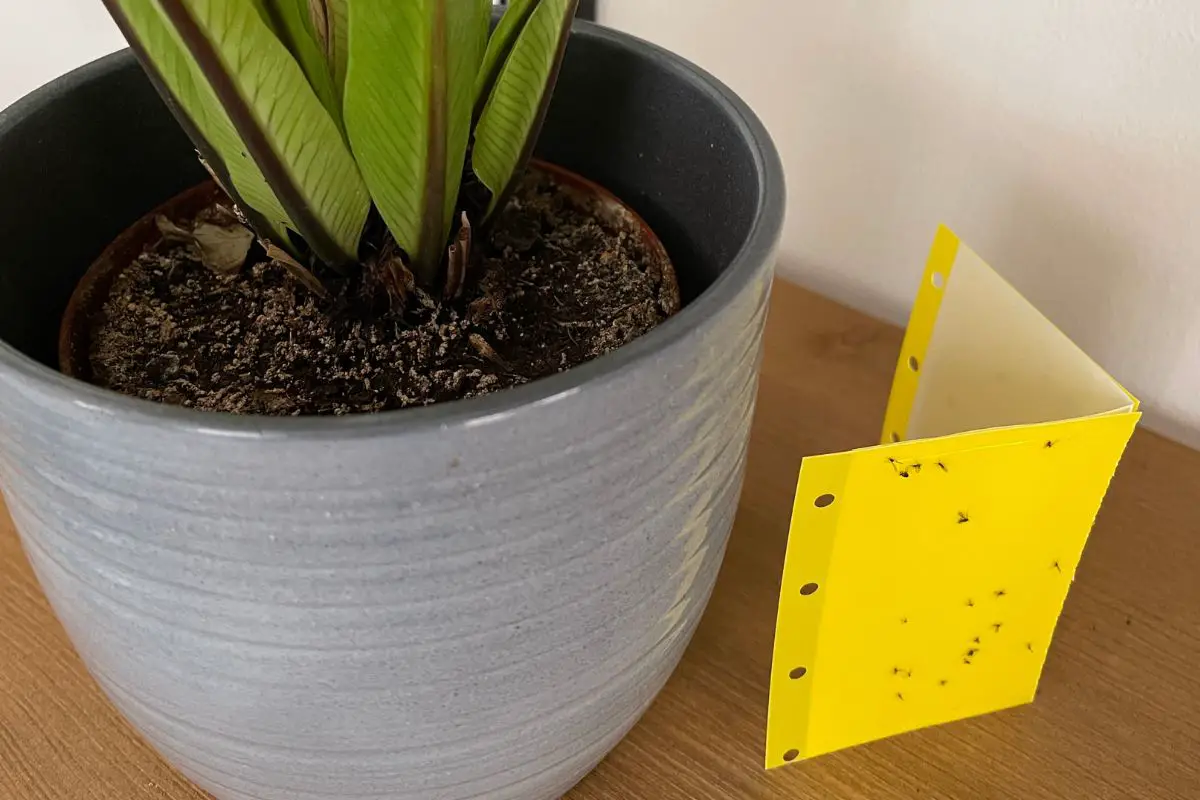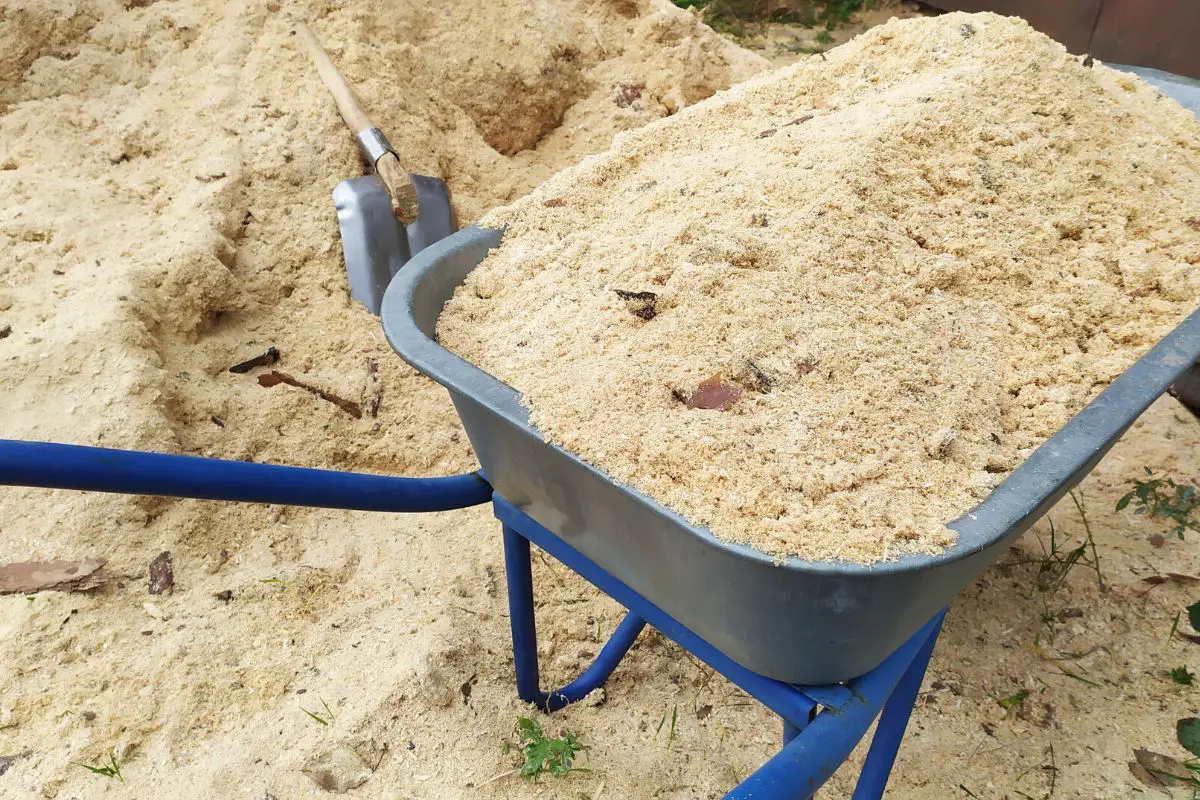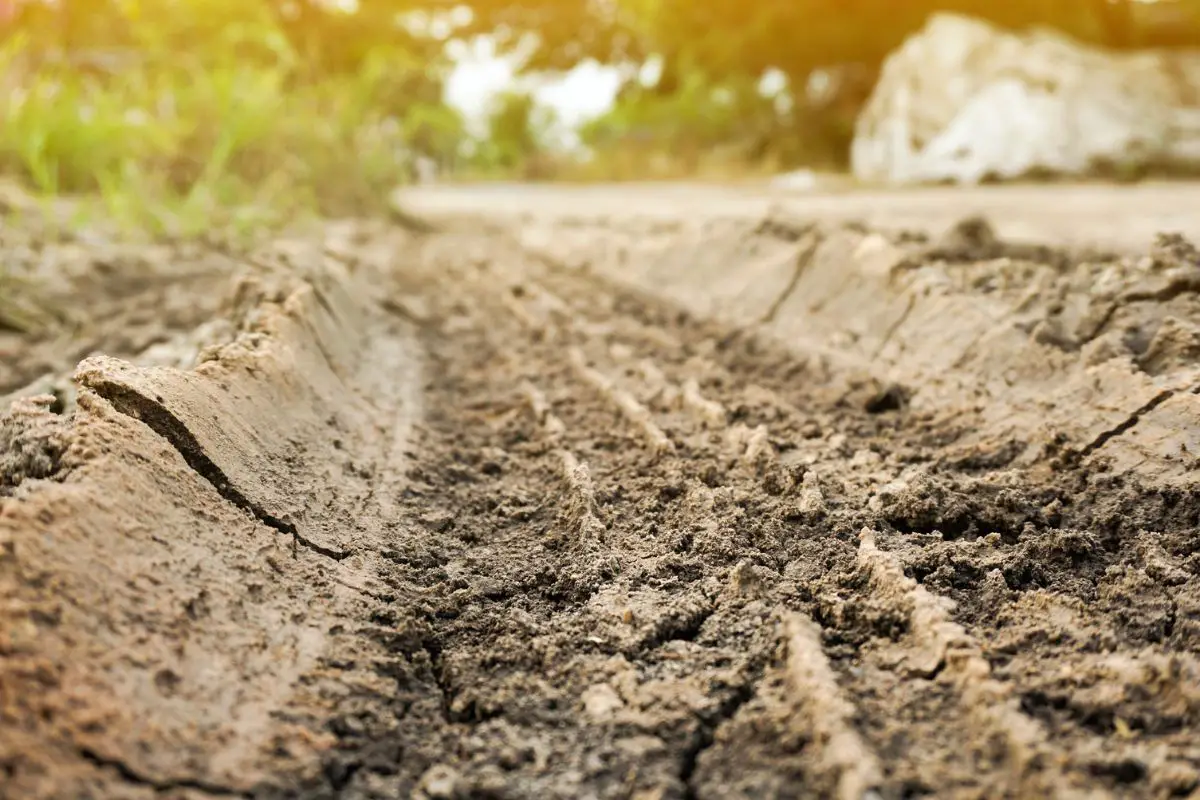Mulch is a gardening essential that serves a lot of functions in keeping your plants safe from drought and extreme temperatures. Despite this, most garden plants require mulch applications only once or twice a year. Luckily, there are bagged and bulk mulch options depending on your garden size, and you can store the excess for later use.
You can store unused bagged mulch in the same bag they came in. Stacking them on a wooden pallet and wrapping them in plastic sheets will keep them safe outdoors. However, they’ll last longer when stacked on racks indoors where it’s cool, dry, and airy.
On the other hand, bulk mulch requires much space and must be kept in an even layer on a plastic tarp. You’ll need another layer of tarp to cover the bulk and protect it from moisture, pests, microbes, weed seeds, and heat.
Proper storage of unused mulch, whether bagged or piled, will ensure that it’s in good condition and safe to use in the garden. In the rest of the article, I’ll walk you through the different types of organic mulch and how to properly store your bagged or bulk mulch. Keep reading to learn more.
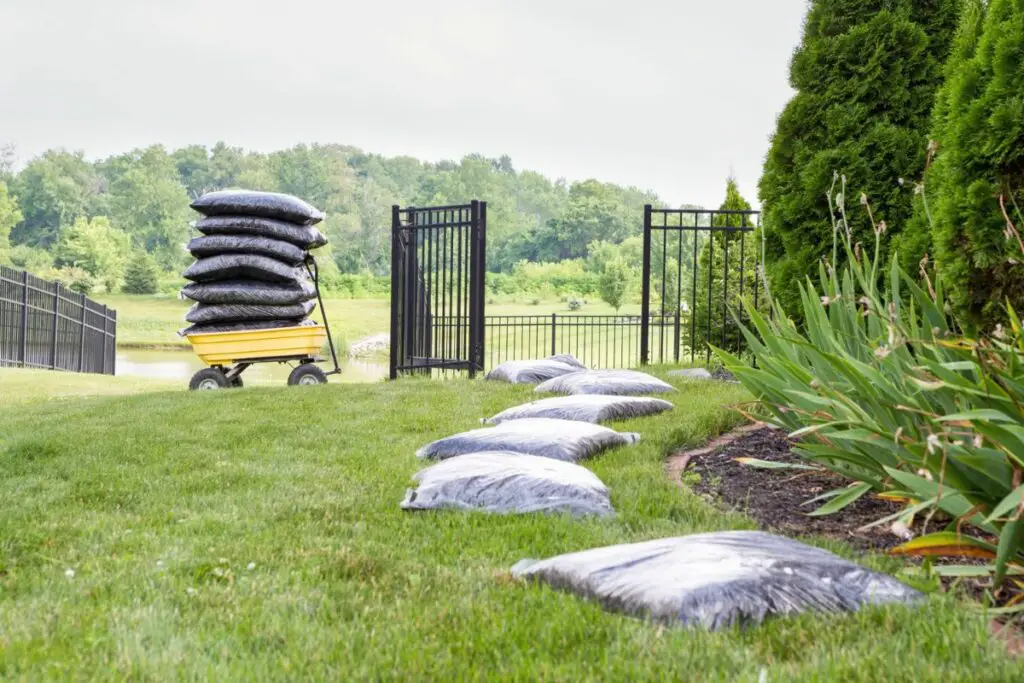
Types of Mulch
Gardeners can choose from a wide range of organic and inorganic mulches available in the market. Although inorganic mulches are reusable and can last indefinitely, organic mulches are much preferred due to their potential to enrich the soil as they break down.
Because of this natural decaying process, organic mulch needs more attention in storage compared to inorganic mulches.
Here are the most widely used organic mulches you can buy in bags or bulk:
Wood Chips
Wood chips are probably the most popular organic mulch materials because of their aesthetic value. They look great on a flower bed, and their irregular shapes and sizes make them excellent for moisture retention, temperature regulation, and weed suppression.
In addition, they can last on the soil for over a year and are resistant to compaction, unlike the finer mulch alternatives, such as sawdust.
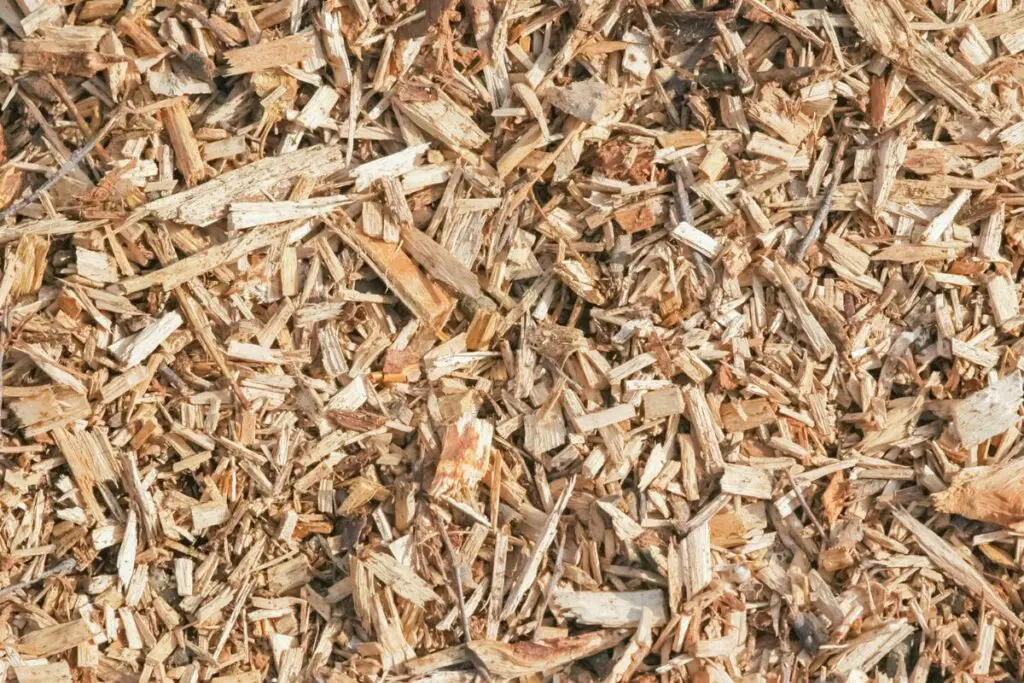
In my experience, bagged wood chips tend to have larger pieces than those sold in bulk by local retailers, who typically offer finer mulch grades. This means that the bagged wood chips can have uneven decomposition times and may take longer to break down, whether they are being stored or used on the ground.
Unfortunately, large wood chip pieces in your garden might suck out much of the nitrogen in the soil because decomposing bacteria and fungi require nitrogen to fuel the decomposition process.
You can prevent nitrogen deficiency by applying only 1-2 inches (2.5-5 cm) of wood chips around your plant. You can also apply the fertilizer directly into the root zone for the roots to absorb more easily.
Bark
Bark is a common waste material at sawmills, which you can sometimes get for a low price, especially when bought in bulk.
Like wood chips, bark is high in carbon and will take a long time to decompose. A 2-inch (5 cm) layer of bark mulch can last about two years on the ground. As such, it is best used around trees or shrubs, which stay in the same spot for a long time.
This material is also excellent for long-term storage. Properly bagged and sealed bark mulch can sit indefinitely under cool and dry conditions. On the other hand, bulk mulch may contain fungi spores and is attractive to molds.
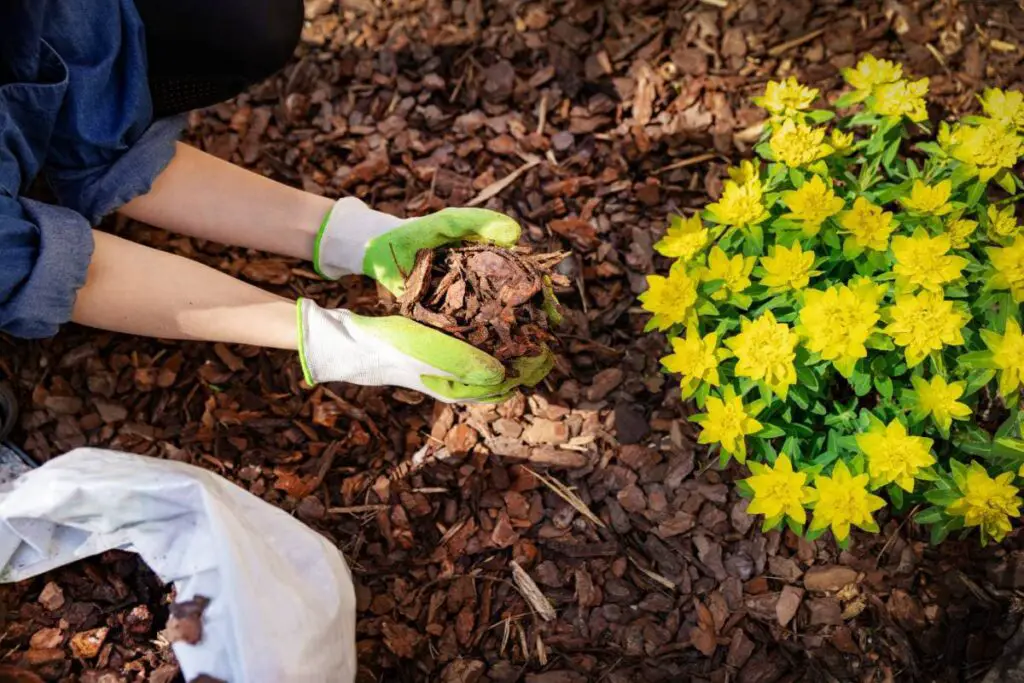
Grass Clippings
If you have a lawn, you may have a surplus of grass clippings. Depending on the growth rate of your grass, you may need to mow your lawn once every 1-2 weeks.
It’s generally safe and even recommended to leave grass clippings on the lawn to decay naturally and return nutrients to the soil. This is especially true if you mow your lawn regularly and the grass clippings are less than an inch (2.5 cm) long.
However, waiting too long to mow your lawn will result in longer clippings. Note that longer grass clippings will take more time to decompose, and they can lead to thatch buildup in the long run.
In that case, you might as well bag the clippings and use them as mulch in another part of your garden—provided you don’t use herbicides. They’re excellent around vegetables as they can help suppress weed growth and regulate soil moisture and temperature.
Alternatively, you can add them to the compost pile if they show signs of going to seed. Compost temperatures above 140 °F (60 °C) will kill the seeds.
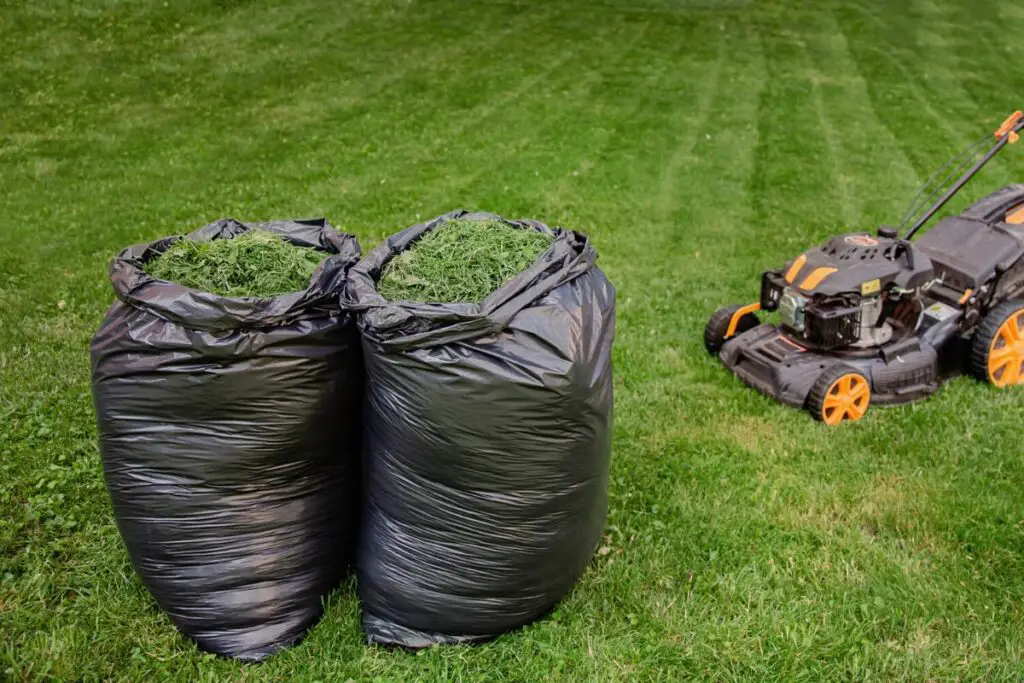
Straw
Straw from wheat, barley, and alfalfa is also an excellent organic mulch material and is widely available.
Straw mulch is effective in controlling weeds and improving moisture retention, making it perfect for vegetable gardens. It also keeps your produce moisture-free since the straw absorbs raindrops and prevents splashing.
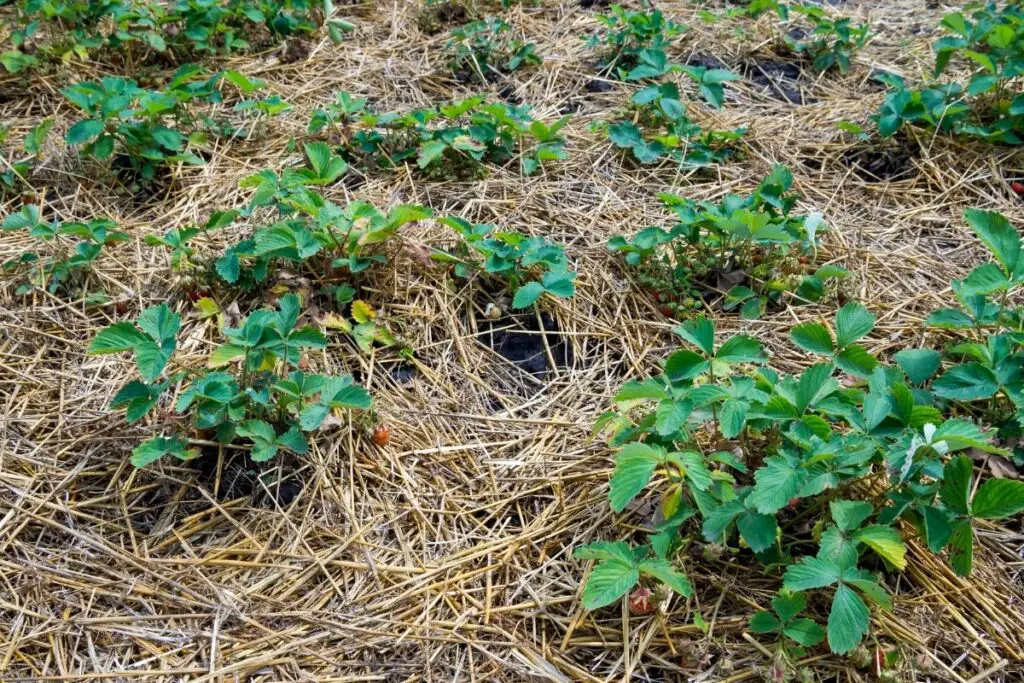
In a well-maintained garden, straw mulch will decompose within one growing season. However, it can take up to two years if the soil lacks nitrogen sources. In storage, the lack of nitrogen will also allow you to keep your straw mulch for a longer period.
One downside to using this mulch is that the straw can be easily blown by the wind when dry. Bulk straw mulch will need a sturdy netting or tarp cover to protect the straw from strong winds.
Sawdust
Sawdust is another waste product at sawmills that you can use to protect your garden soil from moisture loss and extreme temperatures.
You can purchase it in bulk at local lumber or garden supply stores, but it will require extra protection from the wind due to its lightweight. On the other hand, bagged products shouldn’t be stacked so high because those at the bottom will likely become compacted.
Sawdust mulch is widely used in vegetable gardens and flower gardens. However, like with many woody mulch materials, soil microbes will consume a lot of nitrogen from the soil as they try to break down sawdust.
With this in mind, it’s best to use sawdust at the beginning of the growing season when you typically give your plant nitrogen-rich fertilizers. Also, limit the depth of sawdust mulch to 1 inch (2.5 cm) because a thick layer tends to compact above the soil as it decomposes.
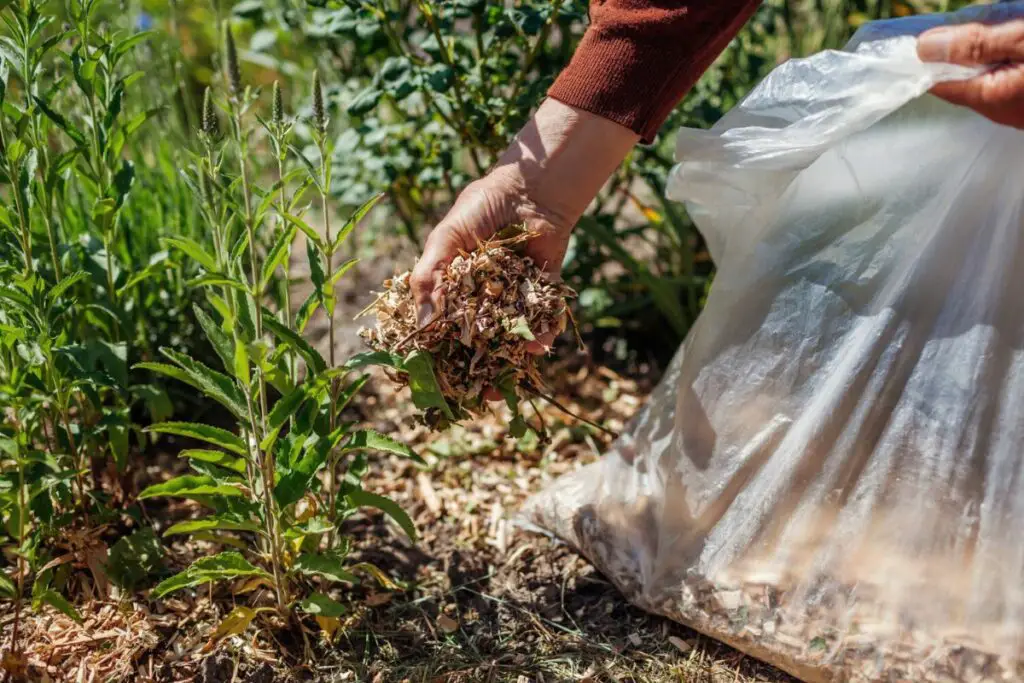
Compost
Among this list of organic mulches, compost is arguably the best. It works as a soil amendment to improve texture and slowly release a good balance of nutrients for the plants to use. It’s perfect for moisture and nutrient-loving plants, such as vegetables and flowers.
In addition, it works excellently as mulch and can more easily be incorporated into the soil within a few months. Unlike straw and sawdust, which sometimes require to be removed to relieve soil compaction, compost is fully decomposed and doesn’t need to be removed.
Compost is readily available commercially in bags at gardening stores. You can also make homemade compost in bulk using yard waste and kitchen scraps. The only downside is that you’ll have to ensure proper maintenance of the pile to ensure proper decomposition.
A finished and properly bagged compost can last about a year in storage. Any longer, and you will notice a significant drop in volume, which indicates a decline in microbial activity and nutritional quality.
On the other hand, finished compost left in a pile will degrade and lose nutrients more quickly. This compost must be used right away and shouldn’t be left to dry out entirely.
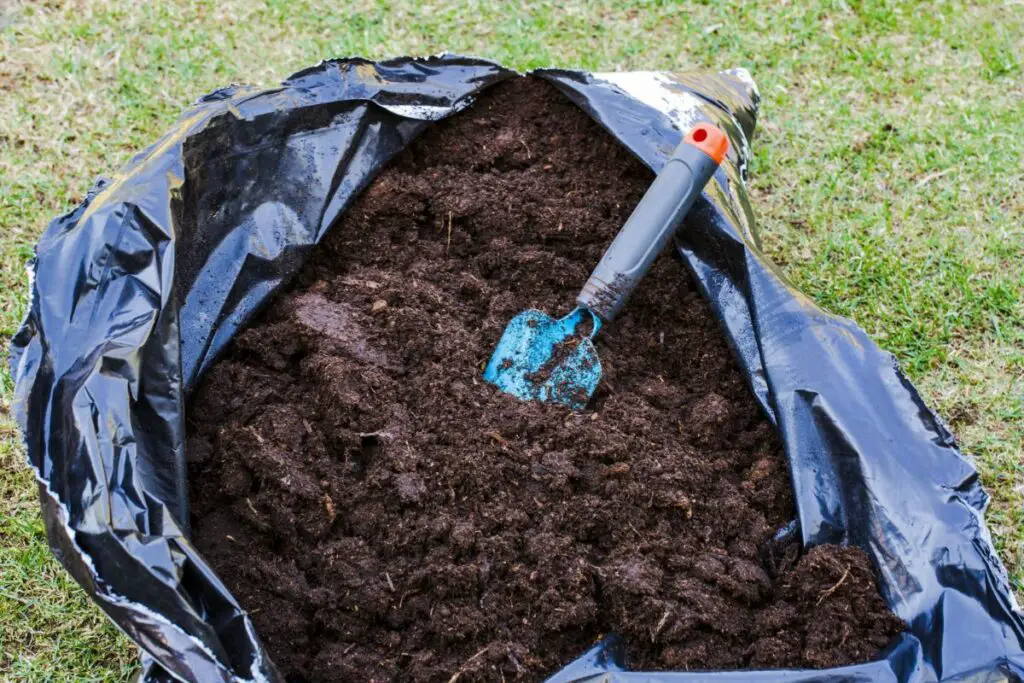
Why Proper Storage Matters
Decomposition is a natural process that all organic matter will go through eventually. However, the rate at which different organic matter decomposes can vary greatly depending on the environmental conditions, such as heat and moisture levels.
If you have been gardening for a long time, you probably know that it is necessary to replace a 3-inch (7.62 cm) deep layer of mulch every 1-2 years due to decomposition. Factoring in the size of your mulched garden areas will limit how much mulch you’ll need in one growing season.
Many experienced gardeners tend to purchase more mulch than they require when buying in bulk for their garden beds or to replenish the existing mulched surfaces, as it is a more cost-effective option.
However, it is important to understand how to store the excess mulch properly. Correct storage conditions can significantly increase the life of the mulch by controlling temperature and moisture levels. On the other hand, if the mulch is stored incorrectly, it can deteriorate in quality and cause damage to your garden.
Below are the consequences of improper storage:
Sour Mulch
A partially decomposed mulch that smells like vinegar or rotten garbage is generally called sour mulch. This happens when the mulch or some sections of it are left wet, initiating a decomposition process.
Poor air circulation deep within the wet portions of the mulch can trigger anaerobic microbes to facilitate the decomposition and release foul-smelling volatile compounds, which give it the characteristic sour smell.
Using this mulch on your plants without pre-treatment will result in rapid plant decline. The symptoms are similar to fertilizer burn, where the foliage develops brown tips and edges, leaf drops, and root or stem rot.
If you notice a slightly sour smell emanating from your mulch, don’t worry. You can fix this problem in most cases by spreading and aerating the mulch for about three days. This will allow the volatile compounds responsible for the sour smell to dissipate, preventing any potential damage to your plants.
Mold Development and Spread
Improper storage of mulch can lead to the growth of mold, which is a collection of fungal mycelia or fruiting bodies. While moldy mulch may not harm your garden directly, it can create further complications for you and your household if it is present in your bagged or piled mulch.
For instance, it can release spores that can spread within your storage space or land on your clothes that you might bring home.
Fungi can attract fungus gnats and mites. On the other hand, the scent of mold can draw in cockroaches and slugs, which use it as an indication of nearby decaying matter. Be aware that some of these pests can cause damage to your plants once introduced to the garden.
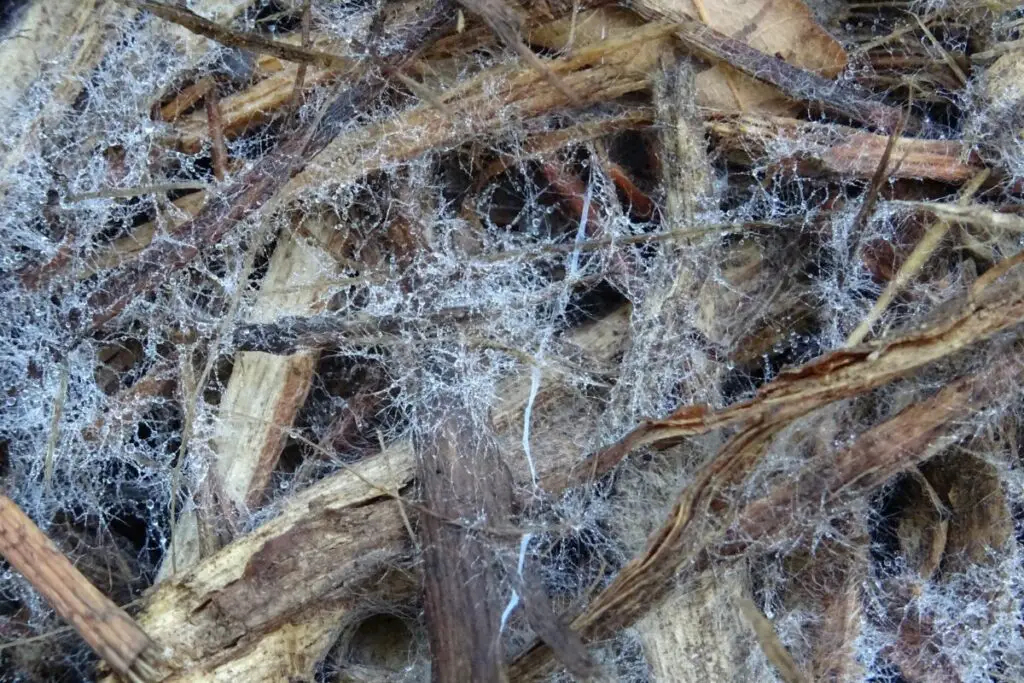
Pests and Diseases
Although mold mites, cockroaches, and adult fungus gnats don’t directly harm plants, they are still unsightly and can be disease vectors. Therefore, it is best to keep them away from your home.
Fungus gnat eggs can persist in the mulch and hatch when the conditions are right. Once hatched and released into the soil, the larvae can feed on plant roots, causing severe damage that can sometimes kill the plant.
Slugs, on the other hand, are common plant pests that voraciously feed on your plant’s stem and leaves once introduced into the garden along with the mulch.
General Mulch Storage Guidelines
When storing bagged or bulk mulch, there are a few general guidelines to keep in mind:
Keep the Mulch off the Ground
The ground may contain high nitrogen levels, microbe decomposers, and moisture that can stimulate a faster decomposition process. Although it can be beneficial for applied mulch, you’ll want your stored mulch to delay decomposition as much as possible.
Choose a Dry, Well-Ventilated Storage Area
Moisture is one of the most important driving forces of the decomposition process. Even bagged mulches can have a bit of moisture inside, but you can prevent the mulch from breaking down quickly by ensuring the area has enough air circulation.
A roofed and walled area, such as a garage or garden shed, is also ideal to protect your mulch from wind, rain, and snow.
Check for Signs of Pests or Spoilage Regularly
Once properly stored, you’ll only need to check on your stored mulch once or twice a month.
Observe for any sour or foul smell coming from your mulch. Woody mulch materials should have a distinct scent from their parent material, whereas compost should smell earthy. A moldy or sour smell can indicate excess moisture and that the mulch has started rotting.
It’s also important to keep an eye on the condition of your bagged mulch or mulch pile. Watch out for any physical damage, such as holes in the bags or scattered mulch pieces from the pile, as this could indicate a pest infestation or damage from the elements. It’s crucial to address these issues promptly to prevent any further damage.
You can place pest repellents or sticky traps around the feet of the shelves or pallets to prevent rodents and other crawling pests from getting to your mulch.
For a mulch pile, use a tarp for the bottom and top layers and weigh down the edges with heavy stones. Make sure that air can flow between the upper and lower layers of the tarp.
Let me explain the specifics of storing bagged and bulk mulch in more detail:
Bagged Mulch
Many home gardeners with small gardens opt for bagged mulch because of the following advantages:
- Easier to carry around the yard
- Quick to spread in specific areas, limits shoveling
- Easy to calculate and spread the necessary amounts
- Tidy and requires little cleaning
- Not having to deal with bulk quantities
- Easier to store the excess, if any
In addition to the general guidelines above, here are some other things to remember when storing mulch bags:
1. Check the Bags for Leaks or Tears
The packaging quality of bagged mulch can vary from one supplier to another. In addition, handling and transportation issues can damage the packaging material. Therefore, it’s important to inspect the bags for leaks or tears before storing them.
Sealed Bags
For long-term storage, the bags should be sealed to keep the mulch free from moisture and pests. You can also wrap them in a plastic sheet if you intend to keep them for longer periods (over six months), especially outdoors.
Open Bags
For opened or partially torn bags, you can simply fold and seal them with packing tape to prevent moisture from seeping in. However, if the bag or the mulch has been exposed to moisture, it’s best to dry it out and move it to a storage container.
Spread the mulch thinly and evenly on a plastic tarp and dry it out for 24-48 hours. You can secure the mulch with an anti-insect net to keep critters off while protecting the mulch pieces from the wind.
Once dry, you can move the mulch into a plastic storage container with a lid. The hard material can keep most rodents off your mulch.
2. Stack the Bags on a Rack or Shelf
Ideally, you should store the bags in a roofed area, such as an unheated garage, where you can place the bags or containers on a rack or shelf. Outdoors, you can stack them over a wooden pallet.
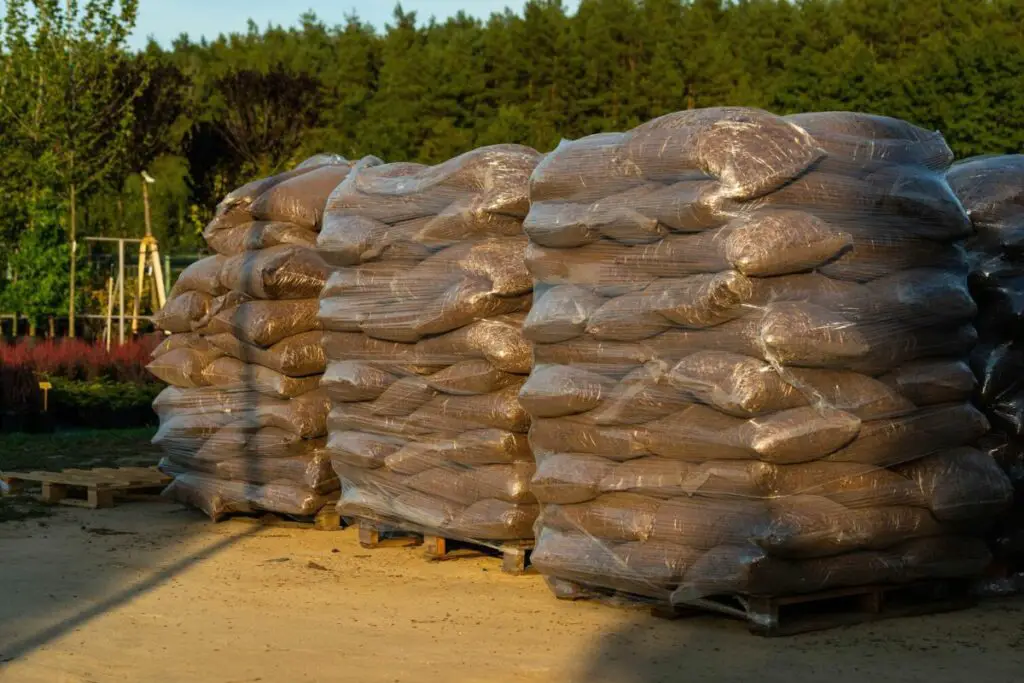
Either way, it’s important to keep them off the ground to prevent rodents from digging through the bags and nesting in the mulch during winter. It’ll also prevent moisture from accumulating at the bottom of the bags and get in through the tears.
When placed on a pallet, limit the stack to a maximum of five to ten bags per pile, especially for finer or shredded mulch types. Otherwise, the weight of the bags can cause compaction to the mulch at the bottom of the pile.
3. Keep the Bags Cool and Dry
The shelf life of your bagged mulch largely depends on how well you maintain the storage space. Since heat and moisture can facilitate faster decomposition, you must prevent it by keeping the area cool and dry, whether it’s indoors or outdoors.
Indoor Storage
If stored indoors, keep the sacks away from the windows, where they’ll be at risk of catching moisture from the rain and snow.
Avoid using heaters in the storage room in the winter. The mulch will last just fine at low temperatures as long as there isn’t much moisture to freeze and thaw within the bags.
Heat, on the other hand, can accelerate organic matter decomposition in the bags. So it’s best to keep your mulch bags out of direct sunlight.
Under the right conditions, your mulch will last indefinitely. However, note that although your mulch will still be usable after a few years in storage, the quality can decline over time. For instance, you may find partially decomposed sections in the bag.
Outdoor Storage
If you decide to store your mulch bags outdoors (i.e., on a pallet), make sure to select a dry and shady location.
You could also wrap the bags together with a plastic sheet for long-term storage. In addition, lay a tarp over your mulch bag stack during rainy days for an extra layer of protection.
In my experience, mulch bags stored indoors have a longer shelf life than those stored outdoors. While mulch bags stored outside usually last around six months, high-quality bags that are stored properly can last anywhere from 12 months to almost indefinitely.
Bulk Mulch
Bulk mulch is usually cheaper than bagged mulch because packaging and shipping costs add significantly to the retail price.
Purchasing mulch in bulk from a nearby supplier can help reduce delivery and other expenses. This is particularly advantageous if you have a large garden, as local mulch vendors usually have trucks that can transport numerous cubic yards of mulch.
Dumping a heap of mulch on your driveway may seem like a convenient option, but it comes with some downsides.
Firstly, you would need to use a wheelbarrow and shovel to transport and spread the mulch to a designated area in your garden. This process can take some time, and during this time, the mulch is at risk of getting moist and invaded by pests.
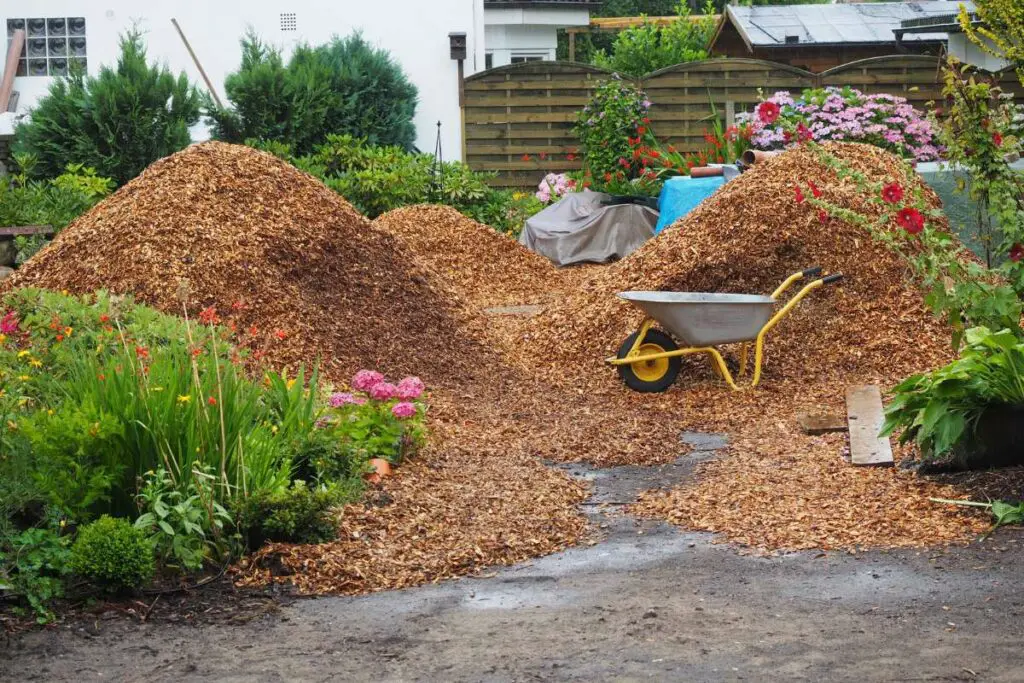
Additionally, if you use colored mulch, there is a possibility that the dye may leach onto the concrete, leaving an unsightly stain.
Furthermore, bulk mulch is often sold in large volumes, which means there is a chance that you may end up with an excess amount. Therefore, it is crucial to store any leftover bulk mulch properly.
Here are some ideas on how to store excess bulk mulch:
Create a Designated Mulch Storage Area
If you have a large space in your garden and a large pile of mulch left, you can create a designated area for mulch storage. You can even ask the local mulch supplier to dump the mulch there.
To create a suitable storage space, keep the following essentials in mind:
- Choose a partially elevated area. You wouldn’t want water to pool underneath your mulch in case of heavy rains.
- Lay a tarp at the bottom. Ideally, the bottom should be moisture-free to prevent the mulch from decaying too soon.
- Line the sides with a sturdy netting. This will protect the lightweight mulch pieces from being blown by the wind while allowing proper ventilation.
- Lay another layer of tarp on top. It’s important to protect your pile from rain. Even the morning or evening dew can promote rotting if your pile is kept moist for too long. The tarp should be long and wide enough to roll down and cover the entirety of the pile in case of heavy rain or snow.
- Secure the tarp layers. Secure the outer edges of the tarp with heavy stones to prevent wind from lifting it.
Use Multiple Layers of Tarp
Alternatively, if you don’t have enough space in your garden or have a small heap of mulch left, you can use multiple layers of tarp.
Here’s how:
- Shovel the leftover or unused mulch, load it onto a wheelbarrow, and place it over a plastic tarp.
- Limit the height of the pile to 12 inches (30 cm) and turn it over regularly with a rake.
- Cover the pile with an anti-insect net to let it dry.
- Once dry, cover the setup with another layer of tarp that’s wider than the first. You can keep the tarp in place using heavy stones or stakes. Keep the sides loose to allow airflow.
Bulk mulch stored this way can last a few seasons as long as the storage area isn’t flooded and receives adequate air circulation. Still, it helps to regularly check on your pile for signs of decay or pest infestation.
Differences in Storage
As you can see, there are general and specific guidelines when storing bagged or bulk mulch, but the key differences lie in the following factors:
Handling and Transportation Considerations
Bagged mulch is much easier to transport because of its compact packaging design. You can carry them around in your garden using a garden cart or wheelbarrow and pour them out directly.
When storing the excess, you can simply reseal the bags and stack them on a rack in your garage. They won’t require frequent inspections as long as you have pest repellents in place.
On the other hand, bulk mulch can be challenging to move from the storage space to the garden because you’ll need to use a shovel to load it onto your wheelbarrow. You may also need to use the shovel again to spread the mulch on your garden bed.
Space Requirements
Considering the packaging design, bagged mulch doesn’t require much storage space. Bags are easier to stack on top of one another and you can even reseal the leftover mulch in its original bag.
In contrast, bulk mulch requires much space and isn’t suitable for indoor storage. Fungi and bacteria can easily grow in a pile and contaminate the indoor space, so keeping unsealed mulch outdoors is best.
Methods to Maintain Freshness
As long as the mulch has been adequately dried before being bagged and sealed, it can remain fresh indefinitely. In addition, you wouldn’t have to check on it as frequently as you would your bulk mulch while in storage. The bags can effectively keep moisture, pests, microbes, and weed seeds out.
Bulk mulch, on the other hand, requires regular and frequent checks to ensure that there’s no moisture buildup or pest infestation underneath the tarp.
Final Thoughts
It’s important to store unused mulch properly because it’ll help retain the quality and extend the usability of your mulch.
Under poor storage conditions, mulch can generate toxic chemicals, such as alcohol and methane, and become a breeding ground for microbes and pests that can harm or even kill your garden plants.
Bagged and bulk mulch have their own pros and cons, but based on their storage requirements discussed in the article, you can make an informed decision on which type of mulch works best for you.

